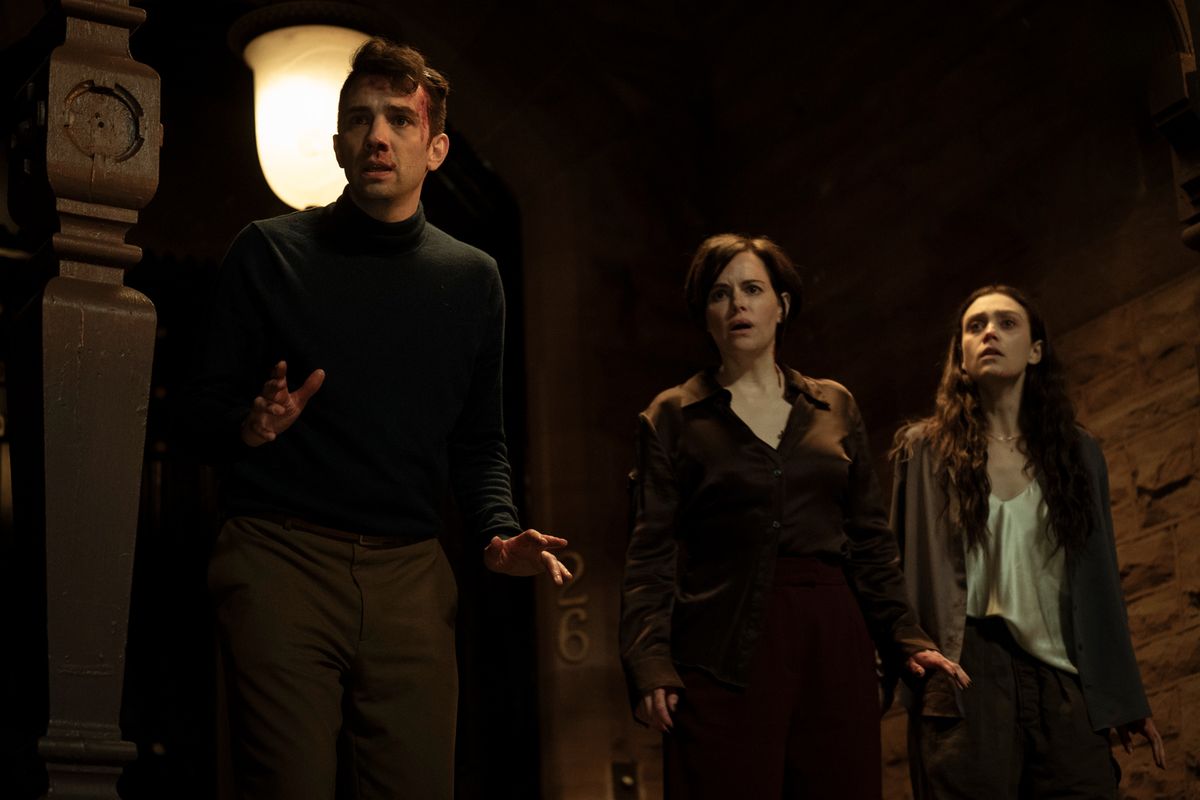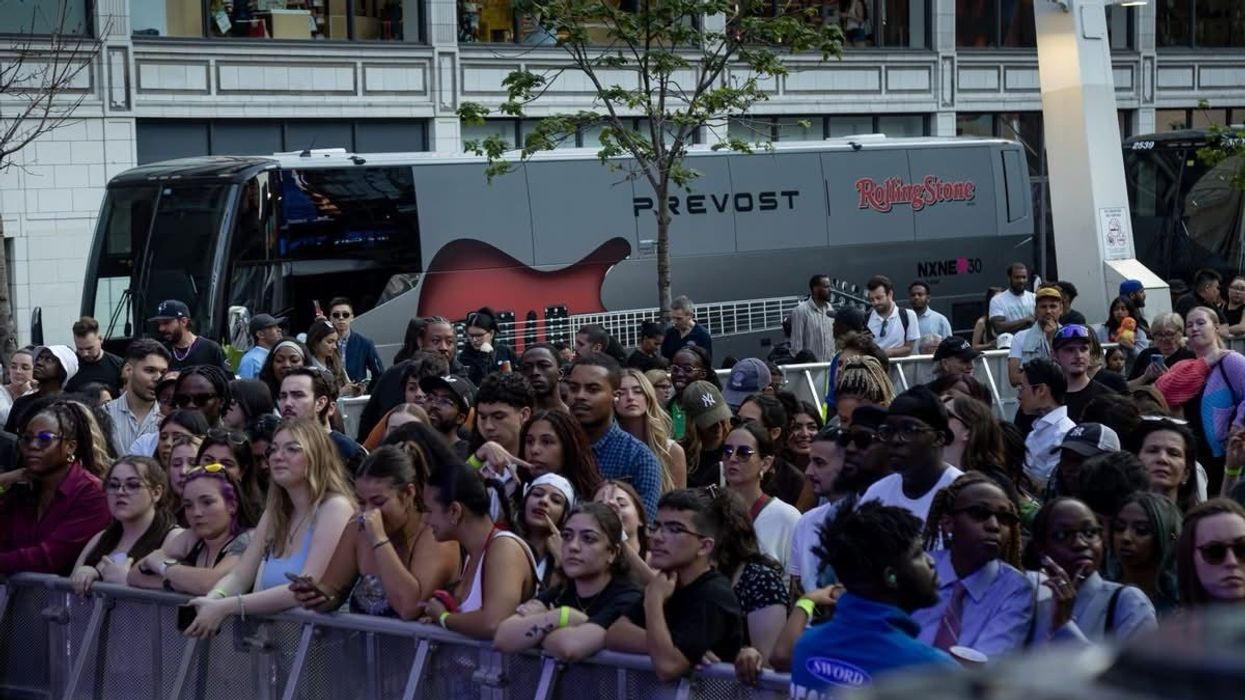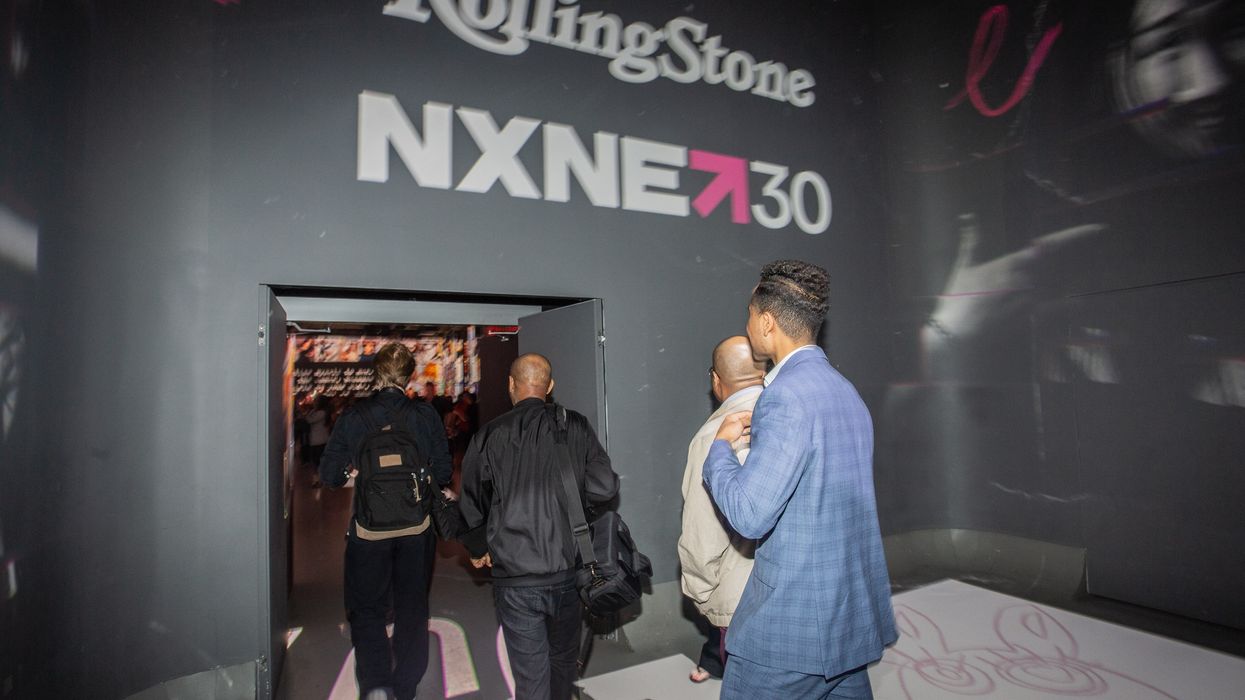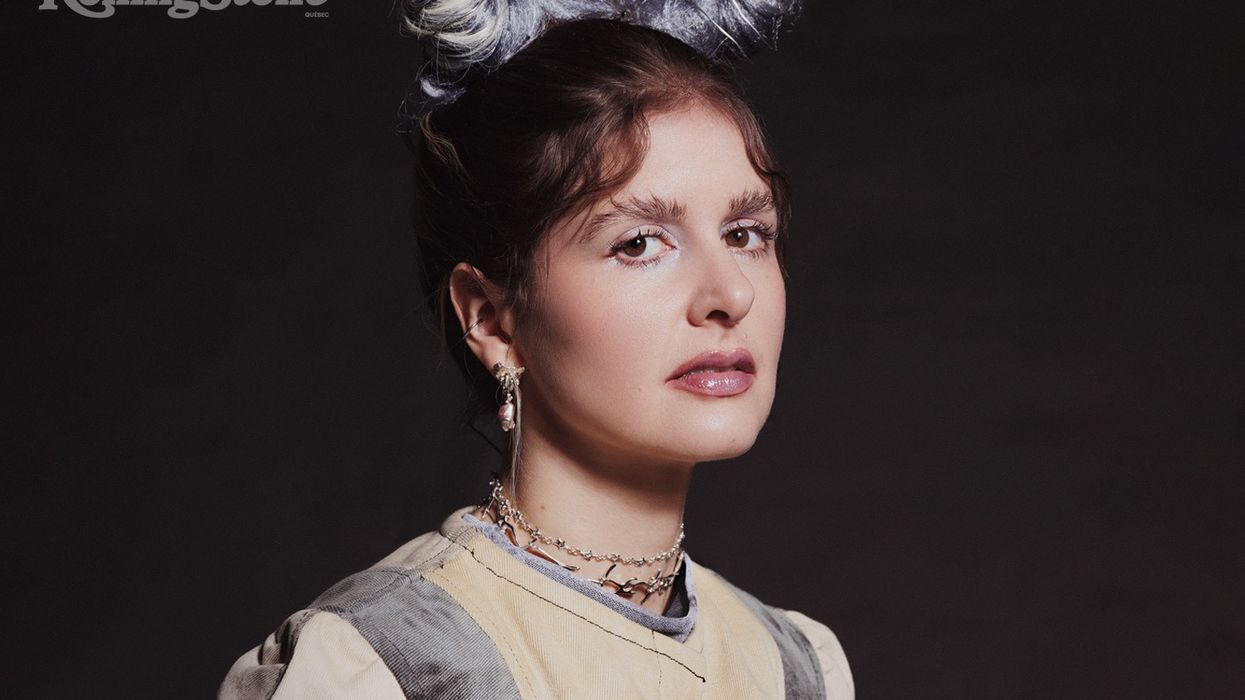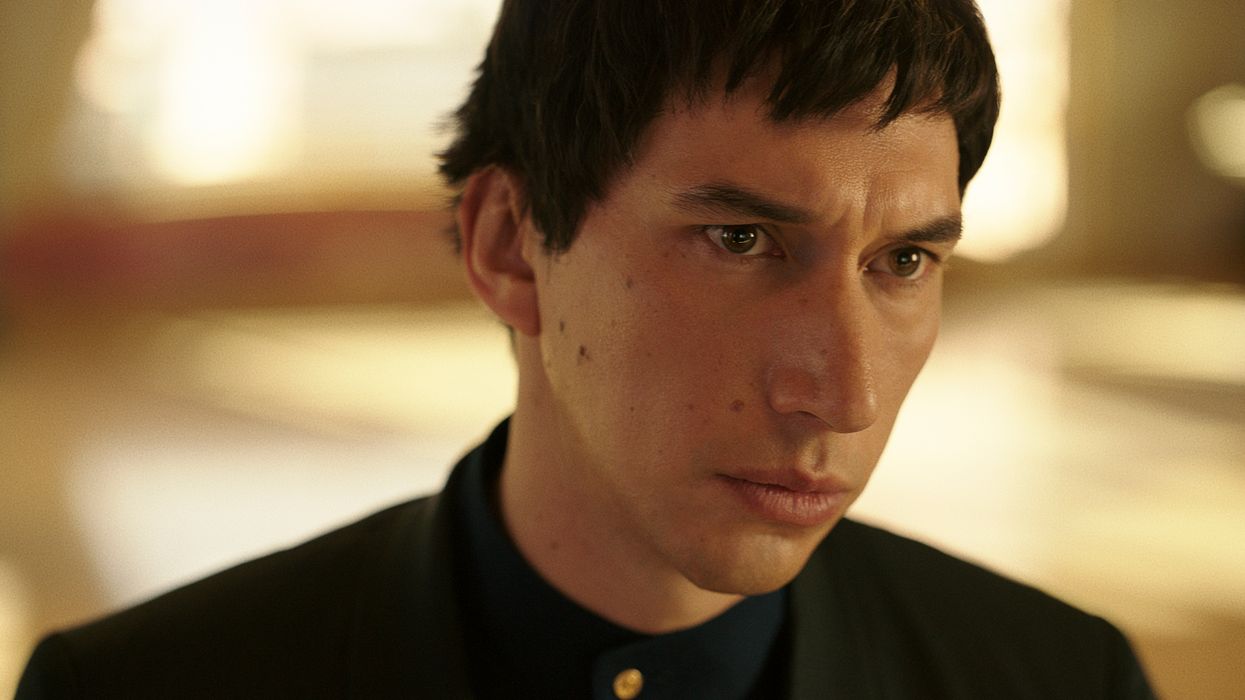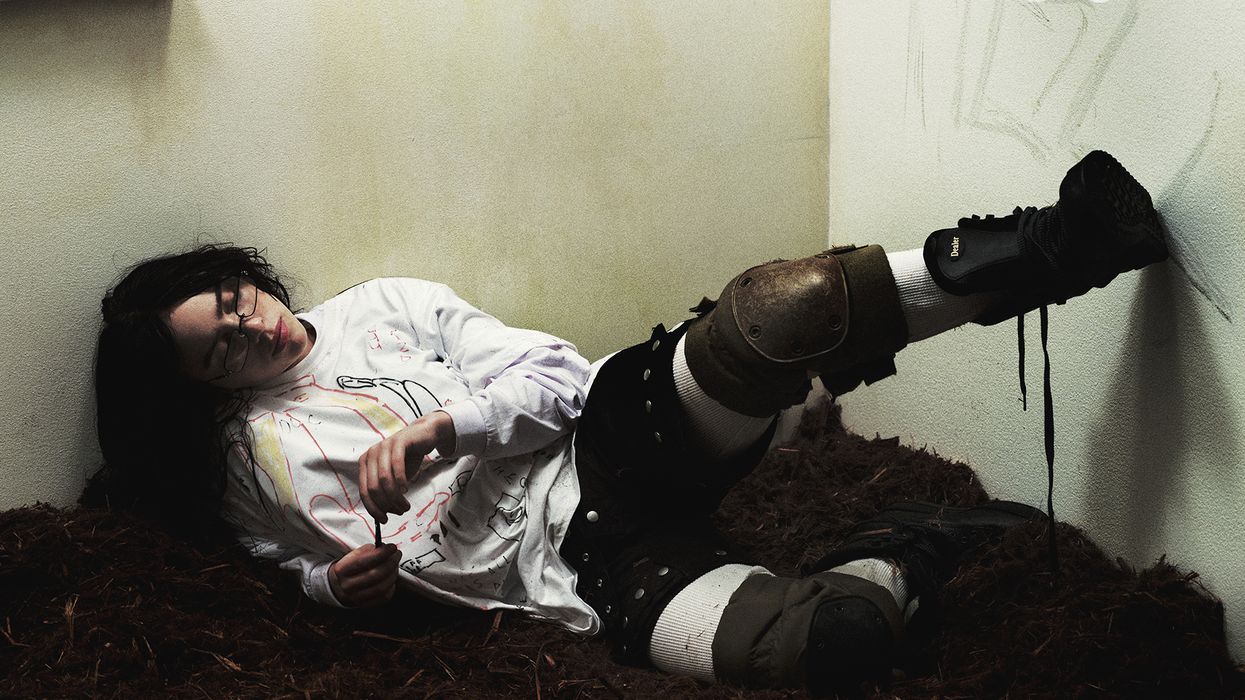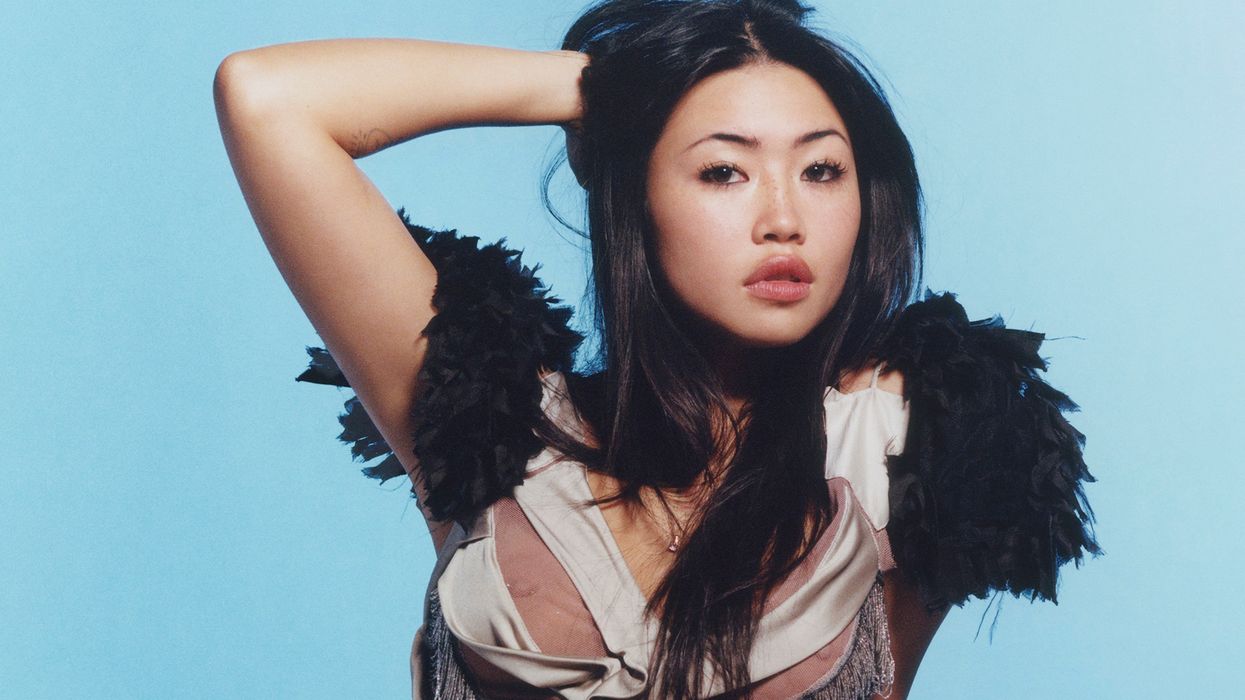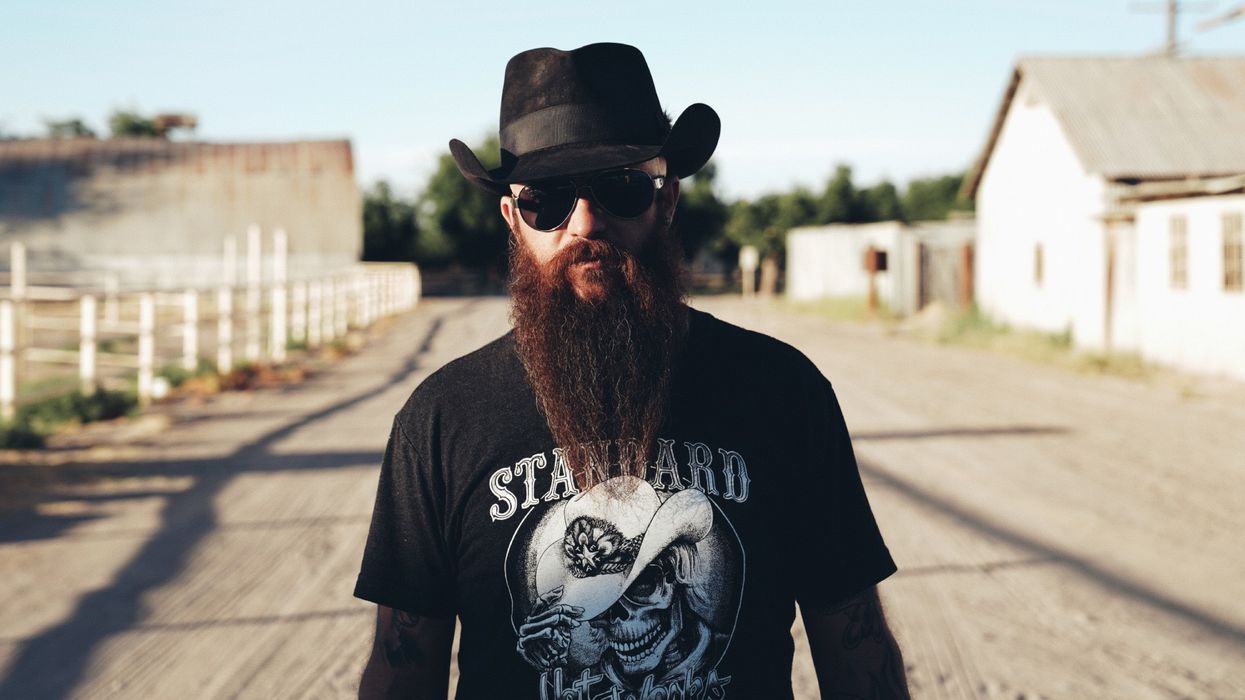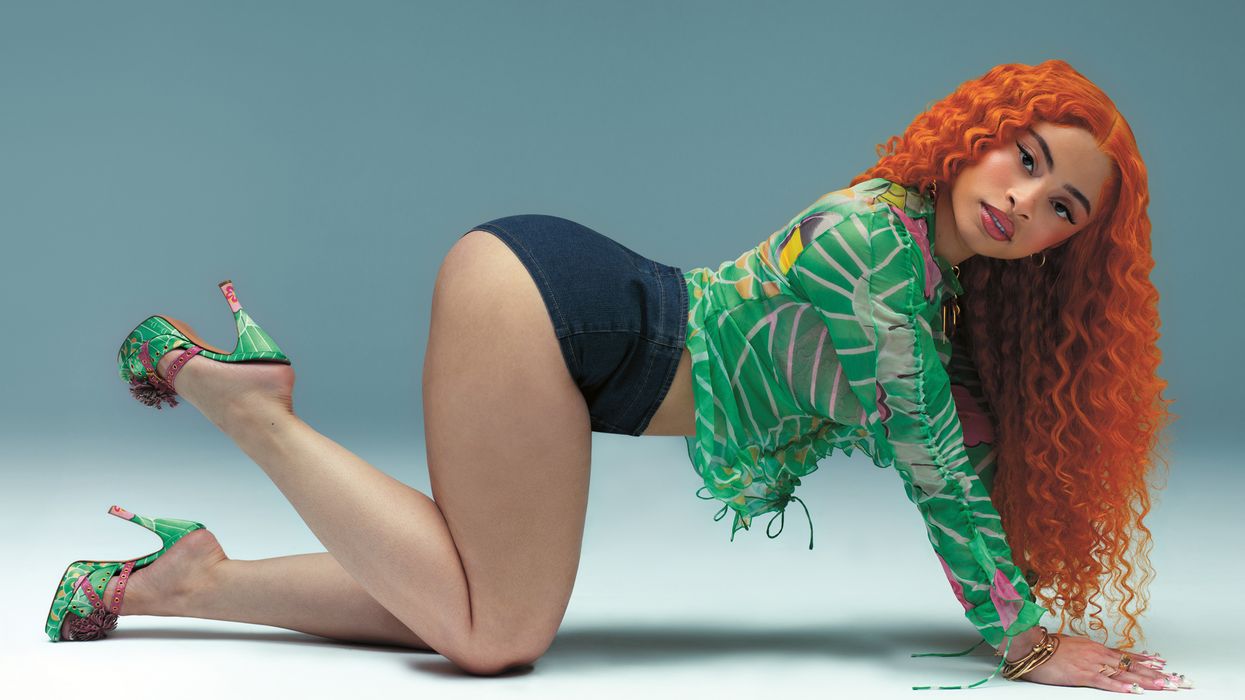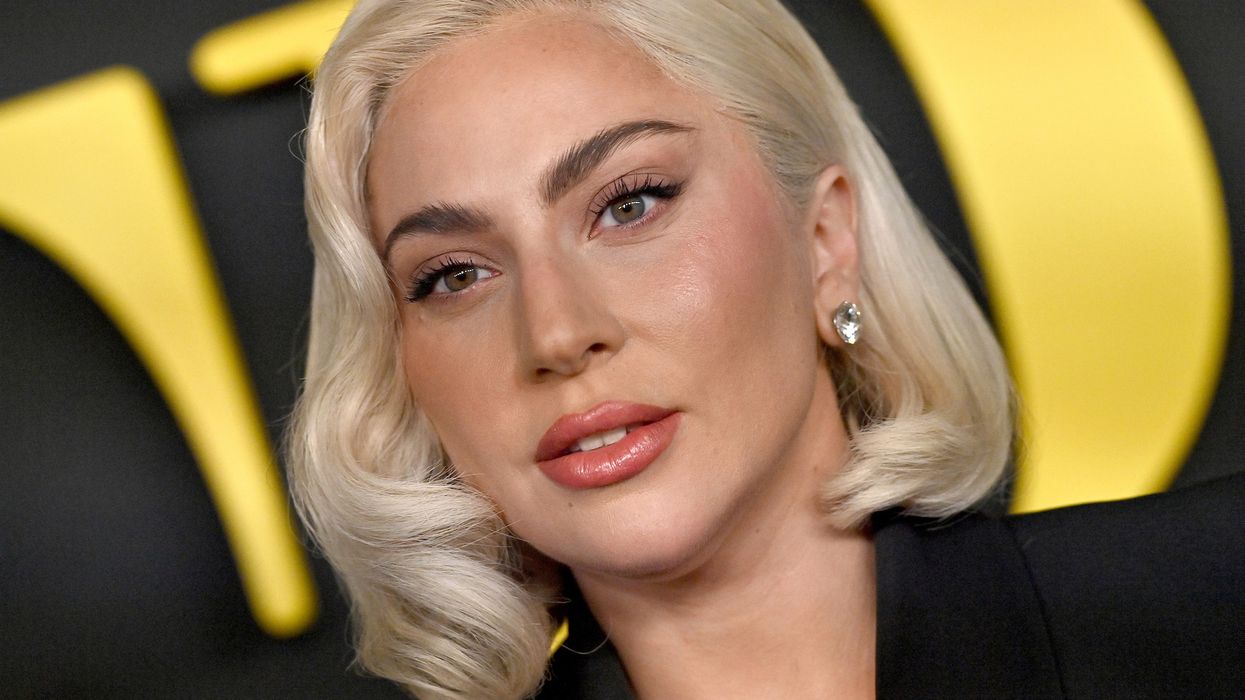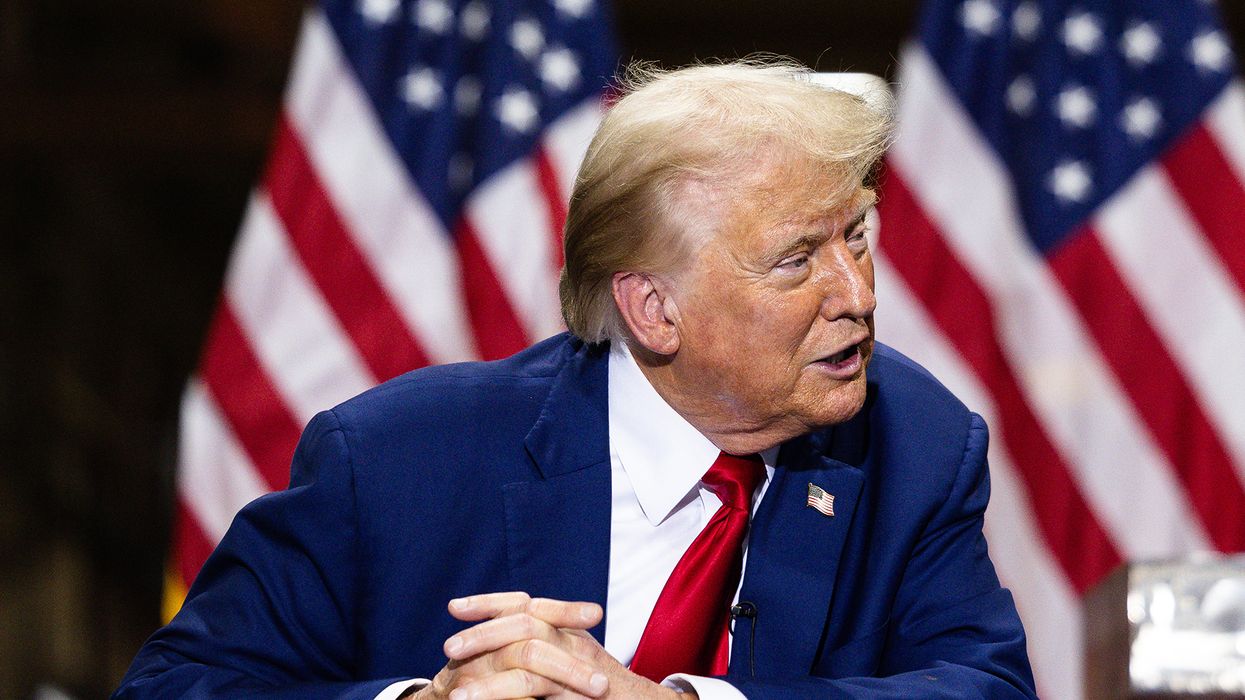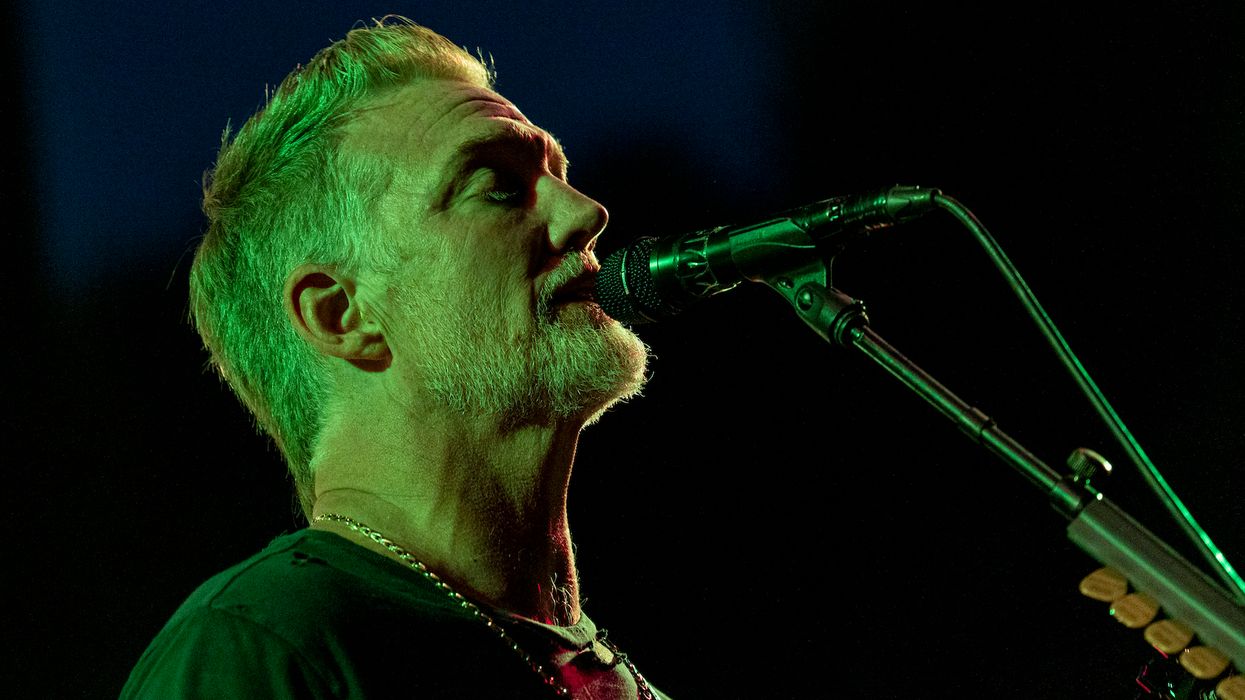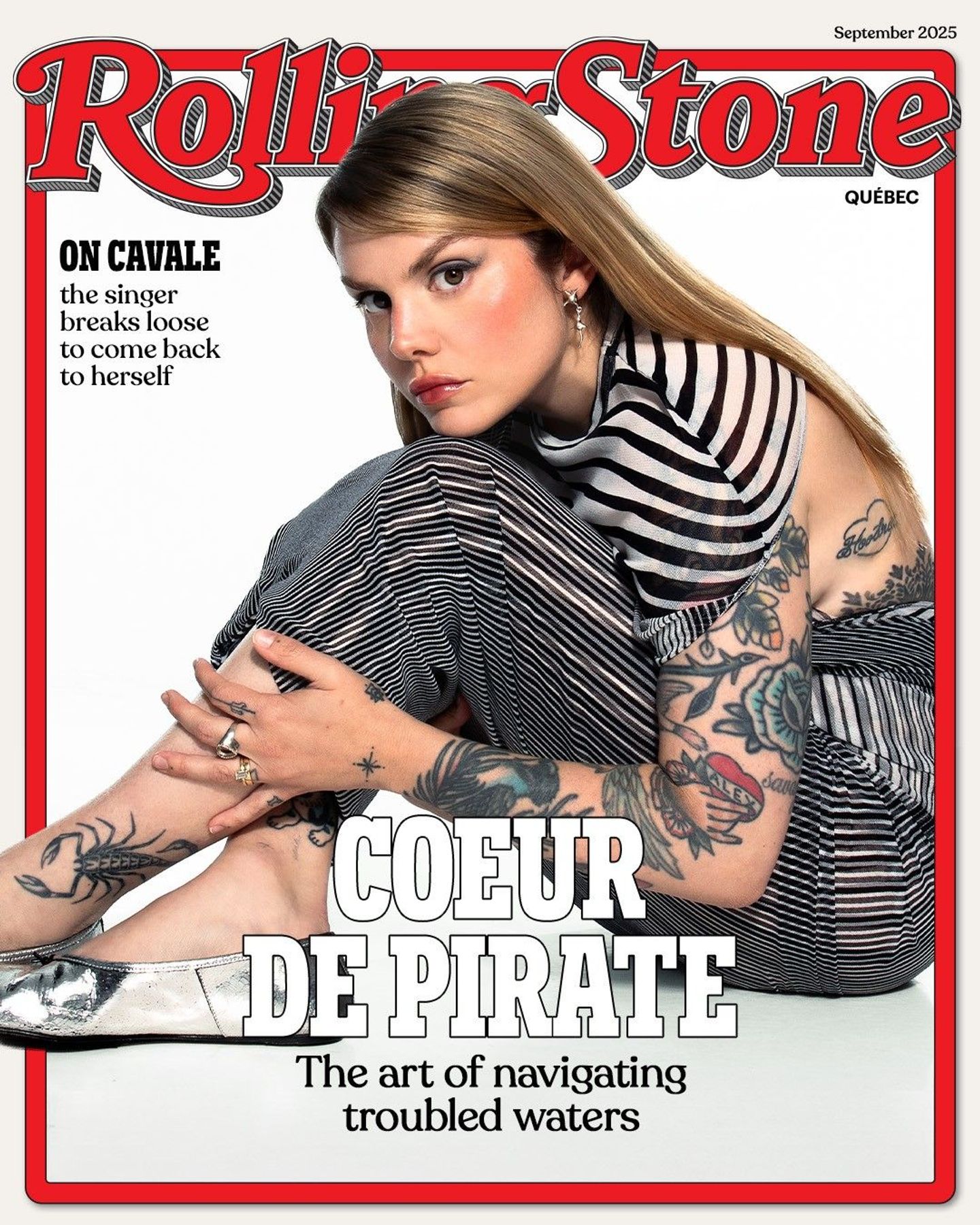Walk into the room where Caitlin Cronenberg is sitting, idly checking her phone and chatting with a friend, and you will be greeted by: CHAOS.
The 39-year-old filmmaker already cuts an imposing figure, courtesy of a mane of dyed red hair in maximum tousled mode, some impressively art deco nailwork and her wide-set eyes, capable of a full-bore stare that Cronenberg uses to unblinkingly punctuate deadpan jokes (and which make her a dead ringer for her late mother). But the thing that you notice first is a small pendant that says, in all-caps, “CHAOS.” It turns out to be self-promotional — she and a business partner are starting a line of jewelry, featuring that single-word necklace; the other options are, respectively, “FUCK” and “NO.” But the contrast of her sheer calmness and her choice of accessories is telling. On the surface, Cronenberg is cool, unflappable, all business. In terms of her creative side: Chaos reigns.
That cocktail of control and anarchy is a key part of Humane, Cronenberg’s debut feature about a dystopian near-future in which, thanks to an eco-disaster of indeterminate origins, humanity finds itself at a crisis point. Governments have started a program in which citizens can voluntarily shuffle off this mortal coil to decrease the population; their families will receive a generous stipend, college scholarships, etc. Some, like the anthropology professor Jared York (Jay Baruchel), are in favor of the few sacrificing themselves for the good of the many. Others, like his piano prodigy/recovering addict stepbrother Noah (Sebastian Chacon) and wannabe-actor stepsister Ashley (Alanna Bale), consider the possible conscription of folks needed to hit the 20-percent-dead goal to be positively barbaric. As for their other sister Rachel (Schitt Creek‘s Emily Hampshire), she’s just happy that the focus is now on mandated euthanasia and not the scandal that’s plagued her tenure as CEO of a pharmaceutical company.
Their parents, a former globetrotting journalist (Peter Gallagher) and a celebrity chef (Uni Park), have gathered the kids together for dinner, in order to announce that both of them have volunteered to die. Except, right after this last supper, Mom takes off. And when the death attendant (Veronica Mars‘ Enrico Colantoni) shows up to administer Dad’s fatal dose, he informs the surviving family members that he won’t get paid unless he brings back two bodies. While he holds Rachel’s teen daughter (Sirena Gulamgaus) hostage, the York clan has to decide who among them will be Collected Corpse No. 2. This the point in which things get nasty. And more than a little bloody. (It opened in theaters this past weekend, and will drop on Shudder on July 26th.)
“I mean, it’s a lot,” Cronenberg says. “You know, it’s a family drama, it’s a social satire, there are elements of horror and comedy in it …when we editing the movie, there was a lot of: This feels too funny, let’s darken things up. Then it was: Ok, things got way too dark now, let’s pull back on that a bit. I kept hearing people referring to it a ‘dark comedy,’ and it was like — if you had told me people would laugh at a cauterizing-a-wound scene, I would have said, ‘That’s not possible. That’s not funny. It’s horrifying!’ But when I finally got to watch the film with an audience for the first time, it was like, ‘Yeah, ok. We somehow made a cauterizing-a-wound scene that is totally gross and funny. I see why people call it a dark comedy now.”
Right, but surely the movie reflects her own sense of humor, right? “Oh, that’s very much sense of humor,” she answers. Her eyes lock in. “I would say I’m fucking hilarious.”
You can detect a certain bone-dry wit in both Cronenberg’s pitiless view of a patriarchal family literally at each others’ throats and some of her answers, which feels less like a hostile response to interrogation and more like a playful heirloom from an artistic family whose work shares a singularly sick sense of humor. (More on the whole surname thing in a bit.) Her initial showbiz aspirations centered around becoming a costume designer, like her aunt Denise Cronenberg. While she was enrolled in school in Toronto studying fashion design, she began dating a guy who’d just won the big prize on Canadian Idol, the country’s version of the hit singing show.
“He was… we were not a great match,” she says. “Let’s just put it that way. We did not have a lot to talk about, at a certain point. So I ended up just taking photos of him with my dad’s camera, one of those early digital Nikons. We broke up after two months, but the photos ended up being used on the cover of a news magazine in Toronto. I contacted them, or they contacted me, and were like, ‘We’re gonna give you $200 for these.’ Okay, this is amazing. And then I was like, ‘But never mind $200. I want a job.'”
Cronenberg worked for the magazine as a photographer for several years, chronicling the occasional bar mitzvah or two on the side for extra cash. Eventually, she graduated from shooting unit stills on non-union film productions to shooting unit stills on union productions, and started doing celebrity portraits for bigger and bigger outlets. Soon, Caitlin was one of those in-demand shutterbugs you called when you wanted offbeat, moody, and/or downright lyrical photo spreads of famous people. She’s shot everyone from Steve Martin to Margot Robbie, Mia Goth to Billie Eilish. That meme-friendly picture of Drake supposedly sitting on talk of the CN Tower, that graces the cover of his album View From the 6? That was Caitlin, too.
One of her earliest assignments for the mag was snapping shots of Michael Sparaga, a writer, director and producer. “I don’t know that our paths would have crossed otherwise,” Cronenberg says. “But that’s how ended up meeting and becoming friends. Like, we have a very sibling dynamic, actually.” And Sparaga was the one who, years later, ended up emailing her a script to read. It was something he’d penned up about a family coming apart during a huge national crisis. The subject line of the email was: “Have you ever thought about directing a feature?”
Which, by her own admission, Caitlin had — and hadn’t — considered trying her hand at feature filmmaking. She’d logged in time doing commercials and music videos, and had made a short film, The Endings, that drew from her photography book of the same name. “That short actually attracted the attention of the people who are now my reps in L.A., who had also told me, ‘Oh, you should be a director.’ And I was like, I’m a photographer — I really enjoy that. Even The Endings, that had just felt more like a moving photo shoot to me. But I guessed I had nothing to lose by exploring this as an alternate, parallel career, because they’re related in so many ways.”
Soon, Cronenberg was being sent scripts, none of which exactly convinced her she should ditch her dayjob. When Sparaga’s email arrived, she opened her friend’s script more in the spirit of curiosity and to possibly offer feedback. “I read it, I laughed, I felt a looming feeling of dread. I felt like the characters were really despicable and fun. All of which made me think, ‘Ok. Maybe.‘
“Keep in mind, it was a very different script at that point,” she notes. “I felt that tonally, we could tighten it and get it darker. But I also wanted to work with him, and I thought that would be a good first experience.”
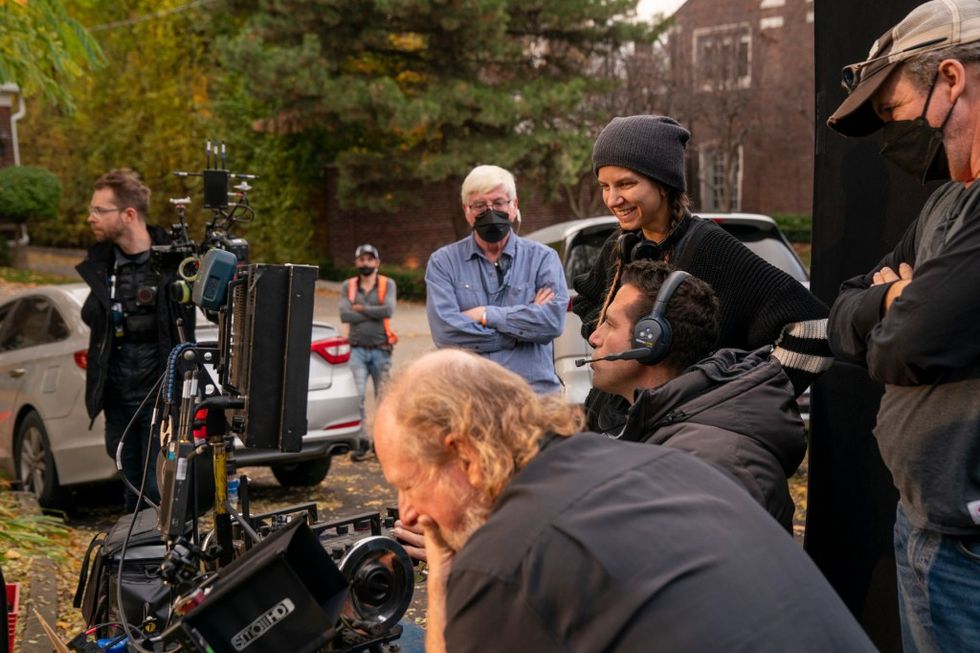
Cronenberg had begun talking to Sparaga about working on this together in late 2019; less than six months later, the world would be in the middle of a global catastrophe, mass lockdowns would be common place and government mandates would turn into culture-war ammunition. Suddenly, the central premise behind Humane took on a whole new relevance. “It changed the world-building of the film, for sure,” she says. “Michael and I would snap pictures of billboards that said, ‘Masks for Children!,’ and creepy things that you could never have anticipated. And I think a lot of things — like, for example, the news reports in the film, they began reflecting the growing way that people felt the government had its own agenda about the issues, and the way that you couldn’t necessarily trust one source. You know, the sort of Fauci of it all. Not that Canada handled it perfectly, but you’d look around the world and hear politicians saying things, and see people fighting ….”
She pauses for a second, then adds, “We were trying to hold a mirror up to a world we saw through Covid, but not try and make people relive the Covid experience. Do you know what I mean? Like, let our grandchildren watch movies about that era decades from now, and we can sit back with a sense of distance and go, ‘Yeah, that’s exactly how it was.’ It’s too soon. But you really saw how people handle themselves, or don’t, during a crisis when that happened. And that aspect influenced our film a lot.”
Once Cronenberg was all in, she and Sparaga began doing what she called a series of thematic and tonal passes. “We did a ‘cringe’ pass, a ‘humor’ pass, a ‘darkness’ pass,” she says. “We kept trying to see I say this with love, but he’d have things like the brothers and sisters calling each other ‘bro’ and ‘sis,’ and I’d just go…No. You’re making me queasy. There were hills that he was willing to die on, and hills I was willing to die on — and that continued in the editing as well, because he’s also a producer on the film. But I knew he would be a great collaborator that I could see spending five years working with him on this, and here we are!”
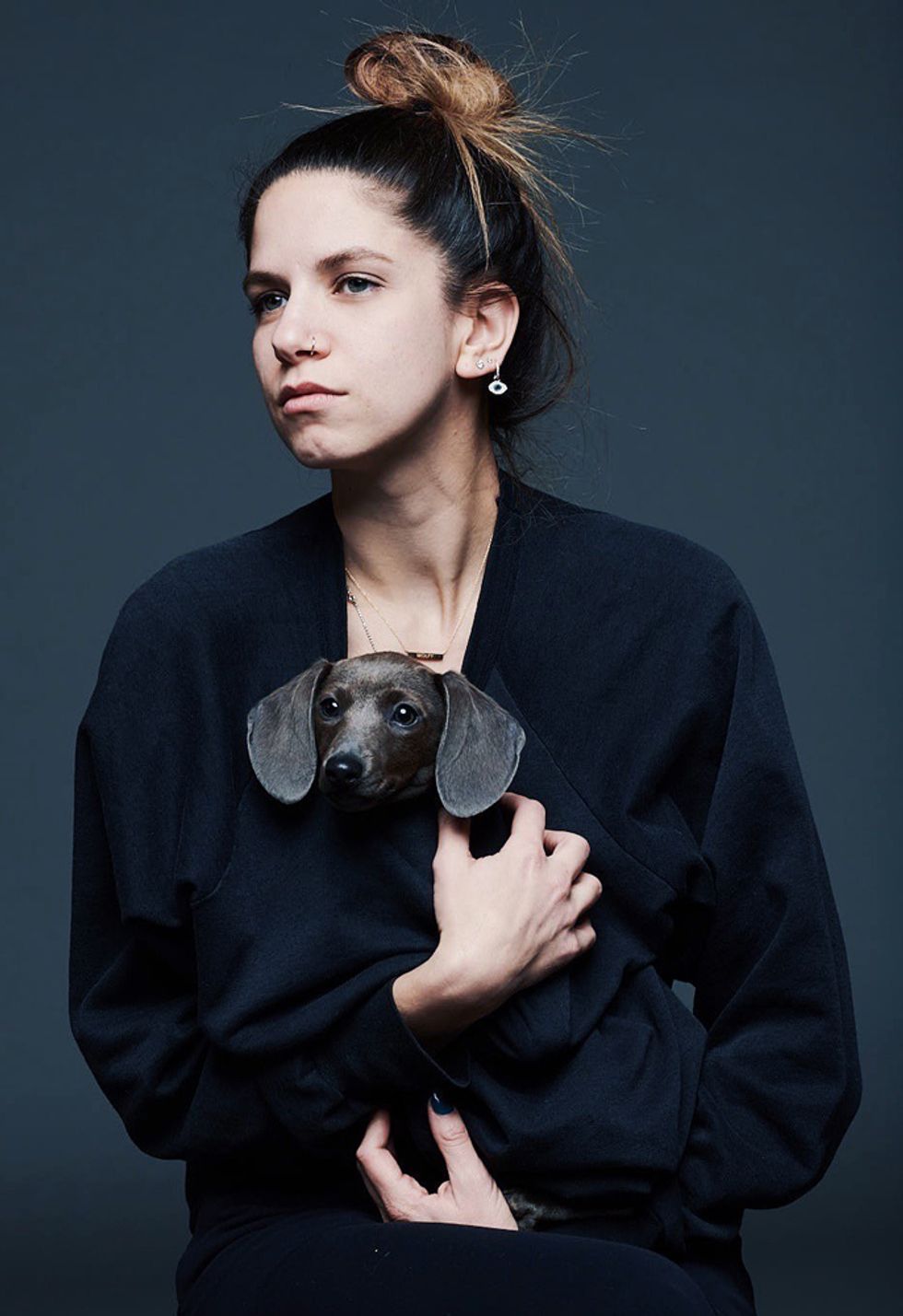
When it came time for the 20-day shoot, Cronenberg is quick to credit her cast (“some of whom are friends, all of whom are talented”) and her director of photographer Douglas Koch (“a master of lighting”) for helping her navigate a steep learning curve. “Stunts were easy to film, because they’re exciting,” she says. “Dialogue scenes are hard, no matter how good your actors or the lines are, because you have to shoot them in a way that isn’t just theater. But also, I didn’t want to do elaborate camera moves or crazy angles just for kicks. I mean, I wouldn’t do that for my photography, unless it’s part of the story you’re trying to tell with that picture — so why do it just because you’re making a film? And having Doug there, who worked on my dad’s last film, was great, because he’s such an old-school cinematographer and could translate what I needed. If I said, ‘I don’t want this to be an assault on eyeballs, I want the lighting to feel like you’re slicing open a soft-boiled egg. Or that it’s like someone is getting a hug…’? He could make that happen.”
The mention of “my dad’s last film” suggests that it’s time to mention the paternal elephant in the room, the lineage that usually gets brought up in the first few lines of anything written about Caitlin. Her father has indeed made films. (“Well, he makes movies in Canada,” she jokes, “so I’m not sure how many people have seen them.”) Close to 50, in fact. Some of these works are, in fact, masterpieces. And as her brother Brandon found out when he began directing films, going into the motion picture business when you’re dad is David Cronenberg is bound to invite comparisons, unflattering comments and the burden of expectations.
“Being the second Cronenberg going into making movies is harder than being the third,” Caitlin points out, “so I have my brother to thank for that. Also, he’s a boy, he writes and his genre is closer and immediately more comparable to what our dad does, so he tends to get that criticism more than I have. I kind of had my own lane with photography, I’ve put books out, people have interviewed me. For him to just step so boldly into that spotlight…. But I think he’s a brilliant writer, I think he’s a brilliant director, I’m his biggest fan. I am always blown away by his work.” (When Brandon invited Caitlin and her husband to an early screening of Infinity Pool, his brilliantly unhinged 2023 thriller, “I immediately called him afterward and said, ‘You wanna talk about anything? You doing ok? We good?!'”)
Caitlin has also collaborated with her dad, shooting him in his short film The Death of David Cronenberg, which featured her father tenderly embracing his own corpse. “Which they hauled up into our house and put in my childhood bed,” she points out. The fact that she could take part in a project he’d designed to work through their grief after his wife and Caitlin’s mother, film editor Carolyn Cronenberg, passed away in 2017, made it that more meaningful to her.
So no, it isn’t like she’s running away from the connection. She just knows that if you bother to look past the shared last name, you’ll see they are all deeply different artists who admittedly share a similar sense of humor — and that’s about it. “We kind of roll our eyes and laugh about how everybody’s still just asking, y’know, ‘What do you guys talk about at the dinner table?'” Caitlin says. “It’s like… well, baseball? Sweatpants has been big in our group chat. Family stuff. Sometimes, we talk about work. But not that often.”
The usual kinds of things that don’t tend to end meals with ambushes, stabbings, painful (but admittedly funny) instances of cauterizing flesh wounds, and all sorts of violent, gory bodily harm. They are one up on Humane‘s family, in other words. Not even forced euthanasia and societal collapse can tear them apart. As for the rest of the what-ifs in Caitlin’s worst-case scenario?
“Are you asking if I think we’re on the brink of total collapse?” Cronenberg asks. Her eyes go wide, then she settles back into her deadpan glare. “It’s a work of fiction, andI don’t actually believe that the government would be so ballsy as to create a voluntary euthanasia program. But! Stranger things have happened. Nothing could surprise me at this point.” Then she smiles, and you suddenly feel like a whole new wave of CHAOS is cresting somewhere off in the distance, ready at any second to crash right on to the shore.
